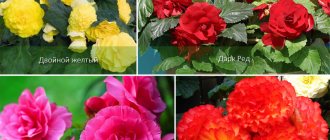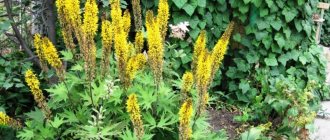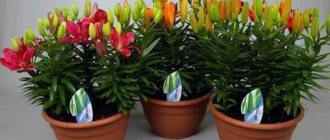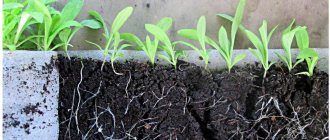Outdoor begonia is an ideal plant for decorating gardens, terraces, and garden paths. It can be planted in open ground, grown in containers and pots, and used for effective landscaping of balconies and local areas. Gardeners usually prefer annual begonias, since their buds bloom in early spring. In this article we will look at the varieties of begonia, its popular types, how to plant begonia, the features of growing flowers in flowerpots and much other interesting information.
Plant characteristics
Tuberous begonia (Begonia tuberhybrida) is an unpretentious perennial plant. It looks great anywhere, is very versatile and extremely popular. Begonias were first described in history in 1690 by the French botanist Charles Plumiere. The name comes from another French plant expert, Michel Begon, and was used as a tribute. However, the delicate colorful flowers were known much earlier - according to historical sources, they were grown in China as early as the 14th century.
Numerous varieties make the begonia flower widespread and very popular among gardeners. The plant has been known in Europe for many years. Garden begonia flowers grow well in our climatic conditions; many varieties are created by crossing numerous species from Africa and the Andes.
Begonia is a small plant, the length of its shoots rarely exceeds 30 cm. The flower tends to branch quickly, which makes it even more attractive. It looks like a small bush decorated with beautiful flowers. The leaves are noteworthy - short, heart-shaped, fleshy and shiny, planted on rather long petioles.
Outdoor begonia blooms from June until the first frost, so it becomes the best decoration for the summer and autumn garden. Winter or ever-blooming begonia (Begonia x semperflorens-cultorum) is also known. Tuberous begonia owes its name to the fact that it forms underground tubers with the help of which it reproduces. Plants planted in the garden look very impressive. These flowers are also suitable for growing in pots, outdoor containers, and on balconies.
Use in landscape design
Photographs of modern gardens and parks are proof that begonias are actively used in the design of park compositions.
Begonias in flowerpots that look gorgeous are fascinating:
- on lawns in the company of plants;
- in individual places;
- framed by flower beds.
Flower beds containing unique flower crops look gorgeous right up to the frost. It’s best to take them home for the winter and plant them back outside in the spring.
Reviews about the flower
“This summer I bought a new flower. Naturally, I had heard about begonia before, but I never thought that it was so spectacular! It was not me who planted it, but my mother, who bought a small bush with flowers and seedlings at the beginning of summer. It blooms very beautifully and makes you happy.” Marianna, Kazan.
“I asked for a gift for March 8, not a traditional bouquet, but a potted plant. So that it would be easy to take care of him. We presented Elatior begonia. It blooms all year round, with bright orange flowers, this variety.” Lyudmila Borisovna, Voronezh.
The blooming Begonia Sadovaya amazes with its magnificence, will delight you all summer, and will become a real decoration of both the garden and the home.
Have a beautiful garden!!!
Save the article on your favorite social network so as not to lose:
Varieties and varieties of begonias with photos
It is difficult to describe in words what begonia flowers look like. Plant varieties represent a huge collection of different colors and shapes.
There are 2 popular garden species that can be grown outdoors:
- Tuberous (Begonia x tuberhybrida) with large multi-colored flowers.
- Semperflorens – ever-blooming or ever-blooming (Begonia semperflorens). Grows up to 50 cm in height, blooms from spring to autumn.
The following species are usually grown at home:
- royal (Begonia rex) - with beautifully colored leaves;
- winter (Begonia x hiemalis) - with extremely noble pink inflorescences.
Some species are annuals and require annual planting, while others, such as tuberous begonias, can overwinter.
There are tuberous varieties with semi-double, double and single flowers. Also popular is cascading ampelous begonia with much smaller flowers. Royal begonia does not produce many flowers; its leaves give it a decorative appearance.
Begonia varieties are difficult to count, their number is huge, as well as the number of variations and varieties. In the house and garden, standard tuberous begonia is most often grown, which is divided into 3 main groups. The criterion for division is the type and size of flowers.
- Large-flowered begonia (Begonia x tuberhybrida grandiflora) is the most popular variety. It differs in flower color and structure - they can have very jagged, fringed edges. The variety produces beautiful, double flowers, a bit like roses. The inflorescences have a diameter of up to 20-30 cm, although when grown on a windowsill they usually do not reach a large size. The flowers are white, yellow, pink, orange, red, burgundy, and there are two-color varieties, for example, white with a dark red border.
- Ampelous begonias are distinguished by the beautiful shape of the bush; they form thin, long, drooping stems. Hanging varieties are better suited for the balcony, where they look great in boxes or hanging pots - flowerpots. The shoots are covered with thin flowers that form large inflorescences and look very attractive. Varieties of hanging begonias differ in color and flower shape - some are simple, others are double, the most magnificent. Cascade begonia is the best plant for shaded balconies.
- Multiflora Multiflora (Begonia Multiflora Maxima) is not a garden begonia, the plant is suitable for a balcony, has tiny flowers. It looks great on the windowsill. Like the royal begonia, this is one of the most popular plants with decorative leaves covered with hairs and painted in different, most beautiful colors and patterns.
Popular varieties
| Name and description of the variety | Photo |
| Camellia bicolor (Bicolor Camellia) pink. The best place is a slightly shaded position, protected from the winds. The soil should be humus, permeable, and moist. Blooms in July – October. Grows up to 25-40 cm in height. | |
| Fimbriata white. White color. Variety: fimbriata - shaggy. Height: 20-25 cm. Flowering: June-September. Leaves in the shape of a heart. Flowers grow in the corners of the upper leaves, have a diameter of up to 12 cm, the petals are curled. | |
| Red fimbriata (Begonia fimbriata). Color: red. Variety: fimbriata - shaggy. Height: 20-25 cm. Flowering: June-September. The flowers are red, up to 12 cm in diameter. | |
| Orange fimbriata (Begonia fimbriata). Variety: fimbriata - shaggy. Orange color. | |
| Fimbriata pink (Fimbriata). Pink fimbriata shaggy. | |
| Fimbriata yellow . Begonia with yellow flowers. | |
| Grandiflora white (Grandiflora). Heart-shaped leaves, dense, succulent flower shoots. The flowers grow in the corners of the upper leaves, with serrated petals. The underground part is a flattened bulb covered with a thick dark brown skin. | |
| Grandiflora red bulbous (Grandiflora). Red flowers with serrated petals. | |
| Grandiflora orange. Orange serrated petals. | |
| Grandiflora pink. Pink flowers. | |
| White pendula (Begonia x tuberhybrida pendula). White color. Height: 30 cm. Flowering: June-September. Heart shaped leaves; thick, juicy flower shoots. Flowers grow in the corners of the upper leaves on hanging shoots. They reach a diameter of 7 cm. | |
| Pendula red. Pendula with red flowers. |
Description
The habitat of these plants is geographically located in the African, Asian, North and South American subtropics and tropics.
As a rule, for garden landscape design, 3 types of begonias are most often used, which are further divided into a large number of varieties:
- tuberous - the height of the bush is about 3 cm, the flowers are large, reaching a diameter of 20 cm, multi-colored. Male and female flowers can develop on the same plant. This species forms a fleshy tuber. The plant blooms from early summer to late autumn;
- ampelous - the shoots of the plant are long and bushy, flowers of various shades;
- ever-flowering - this species is represented by a huge assortment. The leaf apparatus is small, oval, greenish or brownish in color. Often planted in squares and parks.
According to height, these plants are divided into:
- tall (25-35 cm). The most popular varieties: Volumia, Lotto, Baby Wing;
Begonia garden Baby Wing
- medium (22-24 cm). Varieties: Ambassador, Bada Boom, Bada Bing;
Begonia garden Ambassador
- dwarf (9-21 cm). Varieties: Cocktail, Queen, Ray.
Begonia garden Cocktail
The plant has phytoncidal properties and purifies the air from pathogenic microorganisms. You can often hear the saying: “Begonia in the house is a joy for the owners.” When the plant develops well and blooms, harmony and well-being reign in the house.
Benefits of the plant
- Begonias bloom profusely throughout the summer until the first frost.
- Grows well in sun and partial shade.
- The choice between the available varieties is so great that you can choose between many interesting flower colors and different shapes, reaching from 10 to 30-35 cm in height, with straight or drooping stems.
- The flower can be grown in flower beds, in pots, containers, decorating terraces and balconies.
- Ready-made seedlings are widely available for sale in the spring.
- Young plants can be grown without problems at home on a windowsill by planting tubers bought in a store or stored from the previous season in early spring.
Tuberous begonia - what kind of plant is it, features
Tuberous begonia was bred by crossing different species of this genus. Its main advantage is its beautiful and bright flowering, asymmetrical and fleshy stems. Its flowers come in all kinds of colors.
Begonia is also valued by gardeners for its abundance of shapes and sizes. You can plant plants with erect, hanging stems, a scattering of small buds or large flowers in your dacha. It can be grown both in pots on the windowsill and in the garden.
Benefits of culture
The main advantages of growing tuberous begonia include:
- abundance of species, varieties, hybrids;
- variety of colors;
- interesting bud shapes;
- ease of care;
- long and abundant flowering;
- Possibility of growing indoors and outdoors.
Landing
Growing ever-flowering tuberous begonia is not difficult and is suitable even for amateur gardeners.
Tuber selection
It is important to choose the right flower tubers of the highest quality and prepare a suitable planting site. This is a sufficient guarantee that the plants will be attractive and resistant to disease and adverse weather conditions.
When planting, pay attention to ensure that the tubers are healthy, without signs of mold or rotting. The tubers have a characteristic cup shape, with buds located in the recess. In spring, pinkish buds are clearly visible on them, which indicates health and vitality. When planting, be careful not to break them.
Begonia reproduces from tubers, so it can retain the characteristics of the mother plant. Growing begonias from tubers is not difficult; seedlings and bulbs are usually purchased at garden stores.
Reproduction
In early spring (preferably at the end of February or March), the tubers are divided. This is the best way to propagate begonia. These plants can also be propagated by seeds or cuttings, but dividing the tubers is most effective.
The tubers should be divided so that each one has at least one healthy bud (the so-called ear). Wounds caused by dividing tubers should be treated with charcoal and allowed to dry during the day. Coal can be purchased at a pharmacy; the tablet must be crushed with a knife. This will additionally protect the plant from fungal diseases and rotting. After 24 hours, they begin planting.
Choosing a planting site and soil
Garden begonia, like balcony and potted ones, prefers not to be in the sun. These plants love shade. In a sunny place, the stems are a little thinner, the plant has problems with flowering, and the fleshy leaves are easily burned during the heat. They definitely do better in the shade. That's why they often have other plants in their company: conifers that shade the flowers. For balcony growing, an eastern or southern balcony, but shaded by an umbrella, is suitable.
It is better to choose a planting site protected from the wind, especially for cascading varieties. Fragile stems cannot withstand strong gusts of wind.
The soil should be:
- slightly sour;
- humus;
- quite loose;
- permeable;
- You need to pour a small layer of drainage into the pots - expanded clay, gravel.
Use flower soil mixed with acidic peat and compost. You can add a hydrogel to the soil, which retains excess water and releases it when the substrate dries.
Pots are selected as follows:
- for 1 tuber choose a pot with a diameter of 9-12 cm;
- a pot with a diameter of 15 cm is enough for 2 small tubers (2.5-7 cm in size) or one large one;
- for 3 tubers a good flowerpot or basket with a diameter of 25 cm is suitable;
- there should be 2.5-3 cm of free space around each tuber.
Begonias grow well at temperatures of 20 degrees Celsius, so you can easily grow them on your windowsill at home.
Landing dates
Tubers are planted in pots about 3 months before the planned end of frost - this is the end of February or the beginning of March. If you want the plants to bloom in summer or late spring, it is better to plant in March. Later the plant will take root, but may not have time to bloom or flowering will be greatly delayed.
Planting tubers
Begonia is a plant grown from underground tubers that look like flower bulbs. Growing begonias in the garden and pots on the balcony begins with choosing tubers. It is better to buy flower bulbs from a reliable manufacturer. By the time of planting, the tubers may have buds - a sign that they are healthy and in good condition. You need to be careful not to break or destroy the kidneys.
Begonia requires a very special planting method.
Planting stages:
- Moisten the purchased soil with warm water.
- Fill the pot with soil to a height of about 5 cm from the top edge.
- Make small holes in the ground for each tuber to such a depth that once placed, the top of the tubers is on the surface.
- Plant the tubers in holes in the ground with the concave part pointing upward. If the tuber doesn't have an indentation on either side, look for a tiny pink bud or eye to show the top of the tuber.
- Carefully cover the sides of the tuber with soil, do not cover the top part.
- Place flower pots with begonia tubers in a bright place where the temperature is above 13 degrees Celsius. You can cover the pots with glass or a plastic bag.
- Water the tubers with room temperature water to keep the soil moist. As the plants grow, they need to be watered with more water and more often. Try not to water the area where the leaves grow. You need to pour enough water so that it protrudes onto the stand. After waiting half an hour, empty the drained water from the stand.
- The plant is fertilized once a week with fertilizer for flowering plants.
Hardening, transplanting into soil
Before transplanting into the ground, it is worth hardening the plants for several days - taking them out into fresh air for several hours, gradually increasing the hardening time.
Begonias do not tolerate frost, so it is safer to move or transplant them outside after May 15th. When replanting to a permanent place (beds, containers), you need to carefully lower the plant into the holes, trying not to damage the root ball.
How to propagate crops in the country
You can grow begonia in different ways: by sowing seeds in the ground or using tubers. When sowing seeds, attention is paid to where the plant will grow in the future. If you are planting an indoor crop, the seeds are sown in December. If we are talking about planting flowers in open ground, the seeds are sown in the spring.
The process of growing begonia from seeds is as follows:
- Planting material is purchased at the store. It is desirable that it be granular.
- It is worth planting granules in special peat tablets. They are soaked in water and placed in a container.
- Each seed is placed on a tablet and sprinkled with warm water. There is no need to bury the seeds in the soil.
- The container with the sown seeds is covered with glass or film and placed in a warm place with sufficient light.
- To bring in fresh air, the film or glass is periodically lifted and drip irrigation is carried out. It is important to ensure that the soil does not dry out.
- In two weeks, with the right approach, the first shoots should appear.
- Next, the first feeding of the plants with mineral fertilizers is carried out.
- When the third leaf forms on the sprouts, they can be transplanted into separate pots.
- When the plant is completely strong, it is ready to be transplanted into open ground.
Attention : when planting begonia in a pot or flowerpot that is too large, you may not wait for it to bloom, since it will devote all its energy to growing the root system.
The process of planting a tuber is also not particularly complicated:
- Dense and healthy tubers with buds are selected. If they are large, they can be cut into pieces so that each of them has its own bud.
- Tubers are planted in pots with prepared soil.
- After three weeks, with proper care, the plant will be ready to be transplanted into the garden in a permanent place.
Care
Growing begonia is not difficult. Garden, royal, and ampelous varieties have fairly similar requirements.
Watering
The plant has a high need for water and nutrients. The soil should always be slightly moist, but not wet. Therefore, begonia must be watered moderately, increasing the intensity of irrigation during periods of increased growth. Do not water with too cold water, otherwise spots will appear on the leaves.
Attention! Do not overwater your begonia. The soil should not be too wet, because the plants will rot along with the tubers.
Fertilizer
Fertilizer application is an important element of care. Begonia has a high demand for minerals; the cascade variety is especially demanding of fertilizers. Therefore, like all perennial flowers, you need to feed them quite often. Use ready-made preparations intended for begonias. You can also use fertilizers for other shade-tolerant acidophilic plants. Feeding is carried out throughout the season. The best way to fertilize is to apply fertilizer with watering.
Garden care in autumn, wintering
Garden begonias are not entirely frost-resistant, so if they are grown as perennials, you need to make sure they don't freeze before winter sets in. In late autumn, the tubers are removed from the soil and, after clearing of shoots and leaves, placed in a ventilated container.
Hanging begonias growing on balconies should be treated in the same way. Immediately after the first frost, the plant should be removed from the containers, carefully shaken off the ground and trimmed at a height of about 2 cm above the tuber. After 1-2 days, when the soil is slightly dry, it is necessary to clean the tubers from any remaining soil, remove affected and damaged tubers, leave good ones in a ventilated place.
The tubers are placed in cardboard or wooden boxes and covered with peat or sand to prevent them from drying out. The temperature in a room without windows should be 3-10 degrees Celsius. Tubers overwinter in this way until spring in a dark, dry place.
If begonias are moved home for the winter, they need to be given a few months to rest from flowering. Even in hot climates, plants need rest.
How to properly care for begonia
Caring for tuberous begonia involves proper watering, fertilizing, and a well-chosen location.
Watering mode
Begonia suffers greatly from heat and does not tolerate dry soil. Therefore, it should be watered regularly, especially during dry summers. Watering is carried out either early in the morning or in the evening after sunset. Flowers are watered only with warm water. If the weather outside is sunny but not too hot, watering the plants once a week is enough. In hot weather, flowers are watered daily at the root. It is important to ensure that water does not get on the leaves.
Growing in pots
Potted begonias sometimes resemble tiny roses, which is why they are very popular. Caring for potted varieties is very similar to growing garden varieties.
- Landing place. The main thing is to provide shading; the flower grows well on northern windowsills without sun. Similar requirements apply to the beautiful royal begonia, which is found more often in homes than other species. The tuberous variety can be grown indoors all year round - it does not need a wintering period. The plant looks great in the back of the room - on shelves, on a table.
- Watering . The plant needs fairly regular irrigation - it cannot be filled with water in a pot, but it does not like even temporary drying out of the soil.
- Feeding . If you want to get thick, beautiful flowers, you need to take care of regular fertilization throughout the season - from February, March to late autumn. This is very important because begonias in pots have a very high demand for minerals. Properly selected fertilizers will be the best way to maintain an adequate level of substrate acidity. For this reason, it is worth using preparations specifically designed for fertilizing begonias.
What plants are best to plant tuberous begonia with?
Begonia in the garden combines beautifully with other flowers. It can be planted next to lilies, hostas, irises, lavender, balsam, ageratum, verbena. The main thing here is to choose the right plants according to their care requirements, color scheme, and flowering time.
In conclusion, it is worth noting that with the right approach to planting and caring for begonia, it will delight gardeners with colorful and vibrant flowering throughout the warm period. This flower is not only distinguished by its abundance of colors, but also its ease of care, beautiful green foliage and pleasant aroma.
Having shown a little patience and studied in detail all the subtleties and nuances of caring for this crop, a colorful oasis will appear in your garden, delighting with long and abundant flowering of all kinds of colors.
Diseases and pests
Tuberous varieties of begonias do not get sick often. Sometimes they are attacked by aphids. Sometimes fungal diseases occur:
- powdery mildew,
- gray mold,
- spotting,
- rotting.
You can reduce the risk of disease by growing plants correctly and following the watering regime.
Photo. Powdery mildew on begonia leaves
Begonia propagation
Planting a perennial can be done using seeds or tubers; For propagation, they use the method of dividing the bush, cuttings from stems or leaves.
Cuttings
The procedure is carried out in spring and summer. A suitable stem is selected - its minimum height should be 7 cm. Once the stem is cut, it is placed in a wet mixture consisting of three parts peat and one part sand. Place the container with the substrate in a dark place. The rooting process takes about 1 – 2 months. To propagate a plant using a leaf, you need to take the largest and strongest one. It is placed in the soil so that it stands vertically without touching the soil layer. Place in a dark place and keep there until rooting.
Begonia cuttings
Growing a plant from seeds
The method of propagating begonias from seeds can be used from the beginning of winter to the beginning of spring.
First, a nutrient substrate is prepared: a layer of sand, leaf humus and peat. The seeds are sown and gently and shallowly pressed into the top layer of soil. The first shoots appear after about 2 weeks.
Begonia shoots
Then the seedlings dive. Grown plants are transplanted into separate pots. In July, young begonia begins to bloom. In autumn, the plant is placed in peat and placed in a room where the temperature is kept at 10°C. Closer to winter, tuber formation ends. In the spring, the begonia is replanted in a pot.











